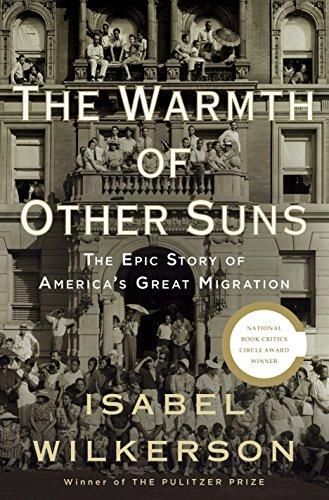Pulitzer Prize winner Isabel Wilkerson, author of Caste, finds telling human details and inspiration in her history of the Great Migration of Black Americans fleeing the racist South.

The Great Migration
Journalist Isabel Wilkerson, the author of Caste, won the 1994 Pulitzer Prize as Chicago bureau chief of The New York Times. With her usual rigor and style, Wilkerson creates an instant classic with this saga of the Great Migration, the mass movement of Black Americans from the South to the industrial north and west. She exemplifies a half-century of sociological upheaval through the experiences of a Mississippi sharecropper, a Florida orange picker and a Louisiana doctor. Writing with verve and eloquence, Wilkerson presents the Great Migration as the most significant untold aspect of United States’ history.
Wilkerson’s reporting garnered the Heartland Award and the Mark Lynton History Prize. Suns earned mentions on top ten or best book of the year lists of The New Yorker, The Washington Post, The Economist, The New York Times, Entertainment Weekly, Amazon, O: The Oprah Magazine, USA Today and many others. The Washington Post called it an “extraordinary and evocative work,” and The New York Times Book Review said, “A narrative epic rigorous enough to impress all but the crankiest of scholars, yet so immensely readable as to land the author a future place on Oprah’s couch.” Recommended companion readings include Wilkerson’s Caste and Barack Obama’s A Promised Land.
The Great Migration
Wilkerson raises and then illustrates the answer to a perpetual question: Is there a safe place for Black Americans – or is their best hope only to find a less dangerous one?
She explains that from 1915 to 1970, some six million Black Americans left the South and moved north and west, mostly to New York, Detroit, Chicago, Philadelphia and Los Angeles. Virulent racism, the author laments, made the South all but uninhabitable for them. For example, Wilkerson quotes a 1933 book, The Tragedy of Lynching, which said that southern whites lynched a Black person every four days from 1889 to 1929, creating public spectacles and enforcing racist hierarchies.
Racial Makeup
The author breaks down the astonishing numbers behind the Migration that forever altered America’s racial makeup. She reveals that in 1940, California had barely 124,000 Black residents, but more than 300,000 Black people moved there during the 1940s.
The migrants had been so relieved to have escaped Jim Crow that many underestimated or dared not think about the dangers in the big cities they were running to – the gangs, the guns, the drugs, the prostitution.Isabel Wilkerson
As many as 10,000 Black Americans arrived in Chicago every month. Detroit’s population was 1.4% Black at the start of the Great Migration and 44% Black by its end.
Ida Mae Brandon Gladney
The first of Wilkerson’s evocative, emblematic citizens is Ida Mae Brandon, who was born in the Mississippi Delta. As a teenager, she married George Gladney and worked the cotton fields. Wilkerson makes clear that life under such circumstances utterly lacked safety. One day, as Gladney picked cotton, her youngest daughter died from eating poisoned plums.
In 1937, the Gladneys decided to leave Mississippi after an incident that Wilkerson depicts as all too typical: Their white boss beat her husband’s cousin with a chain. The boss could have blocked their departure by claiming the Gladneys owed him money, so, as with many Black families, they had to slip away. Wilkerson renders their furtive departure vividly. The Gladneys, she recounts, told few friends or relatives they were leaving and caught a train. They carried almost nothing anyone might have noticed.
Wilkerson conveys how hard George and Ida Mae worked once they settled in Chicago. The author evokes their pride when, after three decades, they bought a house in a white neighborhood.
They believed with all that was in them that they were better off for having made the Migration, that they may have made many mistakes in their lives, but leaving the South had not been one of them.Isabel Wilkerson
But, returning to her theme of pervasive American racism, Wilkerson discusses how Caucasian homeowners eventually vacated the block – depicting quintessential white flight as a racist backlash to the Great Migration. Wilkerson offers a heartbreaking portrait of Mrs. Gladney, alone in her 80s, watching drug dealers, prostitutes, gang members and police officers outside her window. The author insists that even on such a block, Black community values remained. Wilkerson recounts that neighborhood gang members and criminals called Mrs. Gladney “Grandma” and warned her if violence was afoot.
George Starling
George Starling grew up in segregated Eustis, Florida. Florida Agricultural and Mechanical State College accepted him, but, as Wilkerson explains, Starling’s father made his son drop out of college to make money. Wilkerson conveys Starling’s hard life picking oranges during World War II. She recounts how Starling tried to organize workers and had to flee white grove owners who intended to kill him.
Wilkerson reports that after Starling moved to Harlem, he found a good job on the railroad, but when he was working, his family was unsupervised. The author shares the family’s sadness over Starling’s son’s lifelong drug addiction and his daughter’s pregnancy at 13. Wilkerson presents Starling’s life as dominated by sadness before his death in 1998.
Robert Foster
Wilkerson begins Robert Foster’s exodus by tracking his achievements at Morehouse College, before he married and joined the military as a doctor. That level of accomplishment provided no escape from bigotry; Foster’s commander didn’t want a Black doctor treating white patients.
The author follows Foster to Los Angeles, where he established a good practice, prospered, drove a Cadillac and wore the latest fashion, earning the nickname “the Jitterbug Doctor.” Wilkerson presents this as intelligent branding; Foster wanted potential patients to notice and remember him.
He could see the effects of the Migration in his waiting room – former sharecroppers from east Texas, schoolteachers from Baton Rouge, gamblers from Arkansas, Creoles from New Orleans.Isabel Wilkerson
But Wilkerson also captures Dr. Foster as a hard-driving man who spent huge sums on gambling in Las Vegas and never found peace of mind. He died in 1997 at age 78.
Striving and Heartbreak
By burrowing into the lives of three representative Black Americans who were part of the Great Migration, the author depicts a disheartening, maddening variety of the racism every Black American in the Migration had to cope with, one way or another. Though the Migration brought Black Americans hope, greater incomes, higher stability and the opportunity to raise their children in better circumstances than their own, Wilkerson makes it clear that while they could escape the violence and poverty of the South, they could not flee the racism of America. Wilkerson’s elegant prose flows smoothly as she finds humor and love amid her subject’s struggles. Students, teachers and anyone interested in the forces shaping the United States in the 20th century will revel in Wilkerson’s history and insights.









